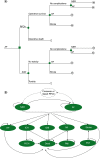Radiofrequency ablation using the ThermoCool SmartTouch Catheter guided by ablation index versus antiarrhythmic drugs in atrial fibrillation treatment in China: a cost-consequence analysis
- PMID: 38205729
- PMCID: PMC10842291
- DOI: 10.57264/cer-2023-0035
Radiofrequency ablation using the ThermoCool SmartTouch Catheter guided by ablation index versus antiarrhythmic drugs in atrial fibrillation treatment in China: a cost-consequence analysis
Abstract
Aim: To evaluate the costs and consequences of two front-line atrial fibrillation (AF) treatments from Chinese healthcare system perspective: radiofrequency catheter ablation (RFCA) using ThermoCool SmartTouch Catheter guided by Ablation Index (STAI), in comparison to antiarrhythmic drugs (AADs). Patients & methods: We simulated clinical and economic consequences for AF patients initially receiving STAI or AADs using a short-term decision tree model leading to a 10-year long-term Markov model. The model projected both clinical consequences and costs associated with, among others, AF, heart failure (HF), strokes, and deaths due to AF or AF related complications. Data informing the models included combination of a local real-world study and published clinical studies. Results: STAI was advantageous versus AADs on all 4 main clinical outcomes evaluated; AF: 25.83% lower (12.84% vs 38.67%), HF: 2.22% lower (1.33% vs 3.55%), stroke or post stroke: 1.82% lower (10.00% vs 11.82%) and deaths due to AF or AF related complications: 0.64% lower (4.11% vs 4.75%). The average total cost per patient in STAI group was ¥16,682 lower (¥123,124 vs ¥139,806). The one-way sensitivity analysis indicated that the difference in total cost was most sensitive to annual AF recurrence probability in AADs-treated patients. Probabilistic sensitivity analysis indicated a 98.5% probability that RFCA treatment would result in cost savings by the end of the 10th year. Conclusion: Radiofrequency catheter ablation using SmartTouch catheter guided by Ablation Index was superior to AADs as the first-line AF treatment in Chinese setting with better clinical outcomes and at lower costs over a 10-year time horizon.
Keywords: ablation index; antiarrhythmic drugs; atrial fibrillation; cost-consequence analysis; real-world study.
Conflict of interest statement
Competing interests disclosure
The authors have no competing interests or relevant affiliations with any organization or entity with the subject matter or materials discussed in the manuscript. This includes employment, consultancies, honoraria, stock ownership or options, expert testimony, grants or patents received or pending, or royalties.
Figures




Similar articles
-
Long-Term Cost-Effectiveness Comparison of Catheter Ablation and Antiarrhythmic Drugs in Atrial Fibrillation Treatment Using Discrete Event Simulation.Value Health. 2022 Jun;25(6):975-983. doi: 10.1016/j.jval.2021.10.014. Epub 2021 Dec 13. Value Health. 2022. PMID: 35667785
-
A Long-Term Cost-Effectiveness Analysis Comparing Radiofrequency Catheter Ablation with Antiarrhythmic Drugs in Treatment of Chinese Patients with Atrial Fibrillation.Am J Cardiovasc Drugs. 2019 Dec;19(6):569-577. doi: 10.1007/s40256-019-00349-1. Am J Cardiovasc Drugs. 2019. PMID: 31090018
-
Clinical and economic impact of first-line or drug-naïve catheter ablation and delayed second-line catheter ablation for atrial fibrillation using a patient-level simulation model.J Med Econ. 2024 Jan-Dec;27(1):1168-1179. doi: 10.1080/13696998.2024.2399438. Epub 2024 Sep 18. J Med Econ. 2024. PMID: 39254662
-
Long-Term Outcomes and Improvements in Quality of Life in Patients with Atrial Fibrillation Treated with Catheter Ablation vs. Antiarrhythmic Drugs.Am J Cardiovasc Drugs. 2021 May;21(3):299-320. doi: 10.1007/s40256-020-00435-9. Am J Cardiovasc Drugs. 2021. PMID: 33000397
-
Assessment of Catheter Ablation or Antiarrhythmic Drugs for First-line Therapy of Atrial Fibrillation: A Meta-analysis of Randomized Clinical Trials.JAMA Cardiol. 2021 Jun 1;6(6):697-705. doi: 10.1001/jamacardio.2021.0852. JAMA Cardiol. 2021. PMID: 33909022 Free PMC article.
References
-
- Calkins H, Hindricks G, Cappato R et al. HRS/EHRA/ECAS/APHRS/SOLAECE expert consensus statement on catheter and surgical ablation of atrial fibrillation. Europace 20(1), e1–e160 (2018). - PMC - PubMed
-
•• Expert consensus statement on catheter and surgical ablation of atrial fibrillation with supporting clinical evidence.
-
- January CT, Wann LS, Alpert JS et al. ; American College of Cardiology/American Heart Association Task Force on Practice Guidelines. 2014 AHA/ACC/HRS guideline for the management of patients with atrial fibrillation: a report of the American College of Cardiology/American Heart Association Task Force on practice guidelines and the Heart Rhythm Society. J. Am. Coll. Cardiol. 64(21), e1–e76 (2014). - PubMed
-
- National Institute for Health and Care Excellence Clinical Guidelines. Atrial Fibrillation: Management. National Institute for Health and Care Excellence, UK: (2014).
-
- Kirisits A, Redekop WK. The economic evaluation of medical devices. App. Health Econ. Health Pol. 11(1), 15–26 (2013). - PubMed
Publication types
MeSH terms
Substances
LinkOut - more resources
Full Text Sources
Medical
Research Materials
Miscellaneous
